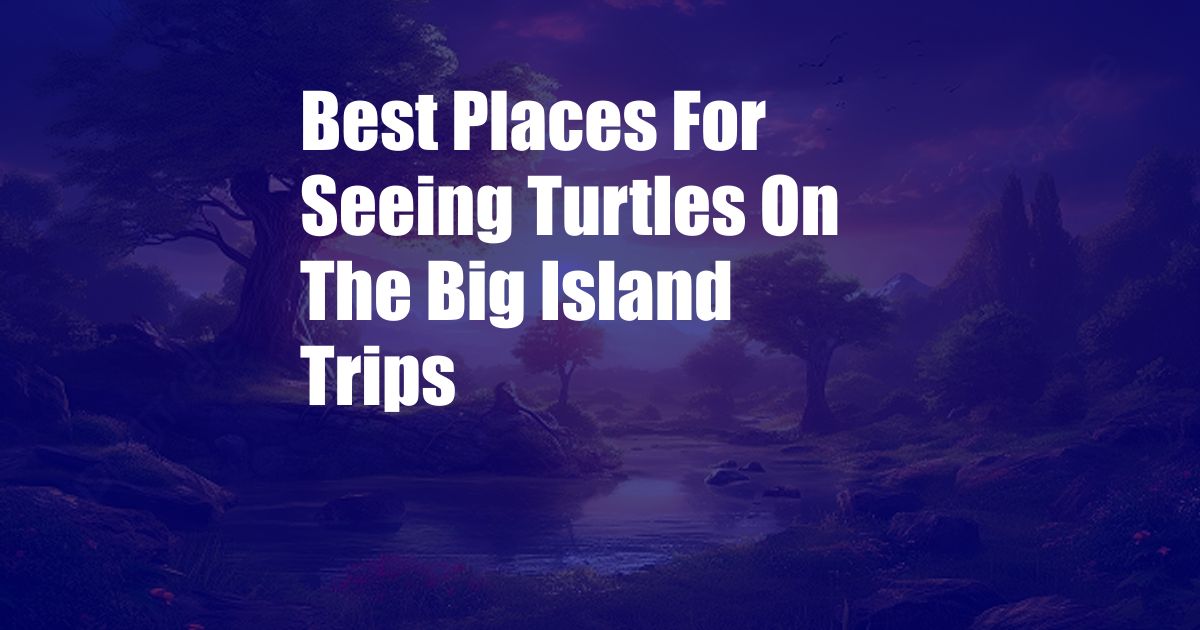
The Big Island: A Turtle Paradise
As I snorkeled along the vibrant coral reefs that fringe the Big Island of Hawaii, I was mesmerized by the graceful movements of a majestic Hawaiian green sea turtle. Its sleek, olive-green shell glistened in the sunlight as it effortlessly glided through the water. I was captivated by its serene presence and instantly drawn to the allure of this extraordinary creature. The Big Island, with its pristine waters and abundant marine life, offers an unforgettable opportunity to encounter these magnificent reptiles in their natural habitat.
The Big Island, also known as Hawaii Island, is renowned for its diverse ecosystem that supports a thriving population of sea turtles, including the endangered hawksbill and green sea turtles. These gentle giants can be observed in various locations around the island, making it a haven for turtle enthusiasts and nature lovers alike.
Turtle Behavior and Biology
Sea turtles are ancient reptiles that have inhabited the Earth’s oceans for over 100 million years. They are highly adapted to their marine environment, possessing streamlined shells and webbed flippers that enable them to navigate the vast expanse of the ocean. Green sea turtles, the most common species found on the Big Island, are herbivorous and primarily feed on seagrass beds. They reach maturity at approximately 30 years and can live for up to 80 years.
One of the most fascinating aspects of sea turtles is their extraordinary ability to navigate the open ocean. Using Earth’s magnetic field and the position of the sun and stars, they can travel thousands of miles during their annual migrations. Female turtles return to the same nesting beaches where they were born to lay their eggs, a journey that can span entire ocean basins.
Turtle Watching on the Big Island
The Big Island offers an abundance of opportunities for turtle watching. Whether you prefer snorkeling or diving, there are numerous sites where you can witness these majestic creatures up close. Here are a few recommended locations for turtle encounters:
- Kahalu’u Beach Park: With its calm waters and shallow depth, Kahalu’u Beach is an ideal location for snorkeling with turtles.
- Keauhou Bay: This pristine bay is home to various marine life, including sea turtles. It offers excellent snorkeling and diving opportunities.
- Pu’uhonua o Honaunau National Historical Park: Located on the Kona coast, this park features a protected marine sanctuary where turtles can be observed from shore or while snorkeling.
- Honolii Beach Park: This secluded beach is known for its excellent visibility and calm waters, making it a great spot for turtle watching.
- Kealakekua Bay: This breathtaking bay is home to a large population of turtles and offers stunning underwater scenery for snorkeling and diving.
Tips for Turtle Encounters
To ensure a safe and enjoyable turtle encounter, it’s essential to follow these tips:
- Respect their space: Avoid touching or harassing turtles. Keep a safe distance and observe them from afar.
- Do not feed them: Turtles have specific dietary needs, and feeding them can disrupt their natural feeding behavior.
- Avoid plastics: Turtles often mistake plastic bags and bottles for food, leading to ingestion and harm. Please dispose of your trash responsibly.
- Use reef-safe sunscreen: Chemical sunscreens can damage coral reefs, which provide habitat for turtles and other marine life.
By adhering to these guidelines, you can help protect these endangered animals and ensure a positive experience for both yourself and the turtles.
Expert Advice
According to marine biologists, the Big Island provides an ideal habitat for sea turtles due to its warm waters, abundant food sources, and protected bays. However, they emphasize the importance of respecting their natural behaviors and minimizing human impact.
Researchers are actively engaged in studying turtles to better understand their migration patterns, nesting habits, and population dynamics. By combining scientific research with responsible tourism practices, we can help ensure the conservation and long-term survival of these remarkable creatures.
FAQ on Turtles of the Big Island
- Q: How old are sea turtles?
A: Sea turtles can live for up to 80 years.
- Q: What do sea turtles eat?
A: Green sea turtles are herbivorous and primarily feed on seagrass beds.
- Q: Where can I see turtles on the Big Island?
A: Recommended locations for turtle encounters include Kahalu’u Beach Park, Keauhou Bay, Pu’uhonua o Honaunau National Historical Park, Honolii Beach Park, and Kealakekua Bay.
- Q: How can I safely interact with sea turtles?
A: Respect their space, avoid touching or feeding them, dispose of trash responsibly, and use reef-safe sunscreen.
Conclusion
The Big Island is a sanctuary for sea turtles, offering an unparalleled opportunity to witness these magnificent creatures in their natural habitat. By following responsible turtle watching practices and supporting conservation efforts, we can ensure that future generations can continue to marvel at these ancient and awe-inspiring animals.
Are you interested in discovering more about the captivating world of sea turtles? Explore our blog for fascinating insights, updates on research, and conservation initiatives that are making a difference in the lives of these remarkable reptiles.